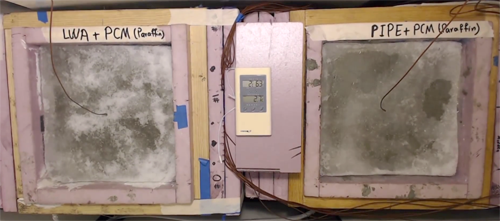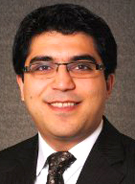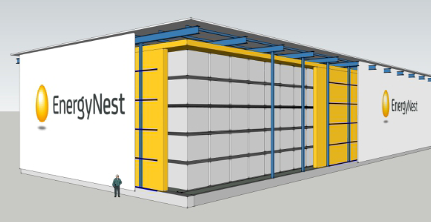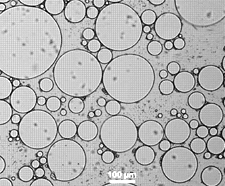 The Phase Change Matters e-mail newsletter is a weekly summary of the latest news and research on phase change materials and thermal energy storage. To subscribe, visit www.puretemp.com/subscribe. For more frequent updates, follow @puretemp on Twitter or visit the Phase Change Matters blog, www.puretemp.com/pcmatters.
The Phase Change Matters e-mail newsletter is a weekly summary of the latest news and research on phase change materials and thermal energy storage. To subscribe, visit www.puretemp.com/subscribe. For more frequent updates, follow @puretemp on Twitter or visit the Phase Change Matters blog, www.puretemp.com/pcmatters.
TRANSPORTATION
Paraffin, methyl laurate show promise in melting snow, ice on concrete

Snow, sleet and freezing rain can quickly slicken runways, causing flight delays and potentially putting air travelers at risk. Imagine a paving material that can absorb the heat of the day and use it to reduce the formation of ice and snow. Dr. Yaghoob Farnam, an assistant professor at Drexel University in Philadelphia, is among the researchers around the world who have been exploring the potential for phase change material to do just that.
Leading a team of researchers at Purdue University, his previous school, Farnam examined the effectiveness of two PCMs as concrete-enhancing agents. The research is detailed in a 2015 paper, “Evaluating the Use of Phase Change Materials in Concrete Pavement to Melt Ice and Snow” (Journal of Materials in Civil Engineering). Farnam recently posted time-lapse videos on YouTube.
 The Purdue team chose paraffin oil and methyl laurate for the study because of their heat storage capacity (about 130 to 170 joules per gram) and phase transformation temperature (about 2 to 3 degrees Celsius).
The Purdue team chose paraffin oil and methyl laurate for the study because of their heat storage capacity (about 130 to 170 joules per gram) and phase transformation temperature (about 2 to 3 degrees Celsius).
The PCMs were combined with mortar in two ways: 1) mixed with lightweight aggregate in mortar and 2) contained in plastic tubes embedded in mortar.
The paraffin oil showed promise in both placements. In the aggregate mix, paraffin-enhanced concrete showed a heat release of 11,000 kilojoules per cubic meter at 3 degrees Celsius. Concrete containing a paraffin-filled tube showed a heat release of 7,500 kJ at 3 degrees C.
The methyl laurate also showed promise in contained form. Concrete containing a tube filled with methyl laurate showed a heat release of 12,000 kJ at 1.2 degrees Celsius. Combined with aggregate, however, methyl laurate showed no heat release. Chemical reactions between the PCM and materials in the cement rendered the PCM ineffective and also appeared to cause cracks in the concrete.
The Federal Aviation Administration supported the proof-of-concept work with nearly $500,000 in grants through its PEGASAS program. The team is now working with Purdue’s Materials Engineering Department to encapsulate methyl laurate and paraffin oil. Farnam is looking for additional funding to continue the research and pursue commercialization.
“A real-world test needs to be done,” Farnam said in an e-mail interview. “Durability and safety of pavements containing PCM needs to be investigated. Encapsulation may be a challenging part. A predictive numerical model is under development, but needs to be completed.”
ENERGY STORAGE

EnergyNest module developed for Masdar now available commercially
EnergyNest put its concrete-based thermal energy storage system to the test last year at the Masdar Institute‘s “beam-down” solar power plant in Masdar City. The Norwegian company says the modular system successfully completed more than 100 charging/discharging cycles and is now available commercially.
EnergyNest says a single module, fitting into a standard 40-foot container, provides a thermal energy capacity of up to 2 megawatt hours. The system uses Heatcrete, a special concrete developed in cooperation with HeidelbergCement. EnergyNest says Heatcrete can store large quantities of thermal energy over long periods and withstand heat of up to 550°C with virtually no performance loss. The system can be operated with either thermal oil (VP1) or direct steam as a heat transfer fluid.
Spokeswoman Jana Erhart says EnergyNest is targeting three segments: “Concentrated solar power, industry and power grid (i.e. more effective integration of wind turbines into the grid via energy storage). Across all 3 target segments the company is in advanced negotiations and expects to close its first commercial contracts by end of this year.”
PATENTS
Silica microcapsules, process of making the same and uses thereof
U.S. patent application 20160236165 (applicant Les Innovations Materium Inc., Granby, Quebec):
 “The present document describes a microcapsule having silica shells, processes for making the same, processes for functionalizing said microcapsules and processes for encapsulating active agent in said microcapsules. … [The] microcapsules of the present invention can contain microencapsulated phase change materials for thermal energy storage, wherein said phase material is selected from the group consisting of n-octacosane, n-Heptacosane, n-tricosane, n-eicosane, n-octadecane, n-pentadecane, n-tridecane, etc.”
“The present document describes a microcapsule having silica shells, processes for making the same, processes for functionalizing said microcapsules and processes for encapsulating active agent in said microcapsules. … [The] microcapsules of the present invention can contain microencapsulated phase change materials for thermal energy storage, wherein said phase material is selected from the group consisting of n-octacosane, n-Heptacosane, n-tricosane, n-eicosane, n-octadecane, n-pentadecane, n-tridecane, etc.”
Thermal insulator with thermally-cyclable phase change material
U.S. patent application 20160237330 (applicant CoolComposites Inc., Waltham, Mass):
“A composite foam insulation material, comprising: a foam insulation matrix; and a plurality of particles distributed within the foam insulation matrix, the particles having an average diameter of between 0.1 and 200 microns and comprising a thermally-cyclable inorganic phase change material capable of undergoing a reversible phase change. “
IN BRIEF
• Encapsys LLC plans to break ground this fall on a new $13 million office and lab building in Appleton, Wis. The microencapsulation services company, formerly a division of Appvion Inc., has remained in Appvion office and lab space since Encapsys was sold to Sherman Capital Holdings in August 2015. “We needed to find new space – for both current business needs and planned growth,” said Mary Goggans, Encapsys president. “And designing our own headquarters building from the ground up is a project that many of our employees are excited to be involved in.”
• New from Transparency Market Research: “Thermally Conductive Plastics Market – Global Industry Analysis, Size, Share, Growth, Trends and Forecast 2016 – 2024”
• Nate Adams, the founder of Energy Smart Home Performance, makes the case for establishing energy-efficiency metrics as an integral part of the residential real estate market. “These metrics,” Adams writes “can create total transparency around ownership costs of homes and influence home values, opening up a new market for Home Performance upgrades and lowering risks for lenders.”
 • New from Pelican BioThermal: Golden Hour Medic, a reusable container that allows combat medics to carry life-saving whole blood onto the battlefield. Phase change material helps keep blood near 4 degrees Celsius for up to 24 hours in harsh conditions.
• New from Pelican BioThermal: Golden Hour Medic, a reusable container that allows combat medics to carry life-saving whole blood onto the battlefield. Phase change material helps keep blood near 4 degrees Celsius for up to 24 hours in harsh conditions.
• Greentech Media reports that the General Services Administration is preparing an energy storage request for information that could be the first step in improving energy efficiency at more than 10,000 U.S. government buildings under the agency’s control.
• The U.S. Department of Energy and the Indian Ministry of Science and Technology have agreed to form a research consortium focused on energy storage and smart grid technology. The U.S. portion of funding for the $30 million project requires congressional approval.
• NRGsim Inc. of Oregon is one of 12 companies reaching the second round of the Department of Energy‘s Small Business Vouchers program this month. NRGsim will work with the National Renewable Energy Laboratory to develop energy modeling and software services for PCM use in building envelopes.
RESEARCH ROUNDUP
For our full list of recent academic research, see puretemp.com/academic. Here are highlights from the past week:
From 4th International Conference on Nano and Materials:• Structural and Thermal Properties Investigation of Stearic Acid Dispersed Fe3O4/TiO2 Nanocomposites for Thermal Energy Storage
From International Communications in Heat and Mass Transfer:
• Confined jet array impingement cooling with spent flow distraction using NEPCM slurry
• Dynamic response of a thermally activated paraffin actuator
• Efficient numerical approach for simulating a full scale vertical ice-on-coil type latent thermal storage tank
From Applied Energy:
• Embodied energy and cost of high temperature thermal energy storage systems for use with concentrated solar power plants
From Chemical Engineering and Processing: Process Intensification:
• Towards improving charge/discharge rate of latent heat thermal energy storage (LHTES) by embedding metal foams in phase change materials (PCMs)
From Solar Energy:
• Development of granular expanded perlite/paraffin phase change material composites and prevention of leakage
From Applied Thermal Engineering:
• Enabeling CHP units for electricity production on demand by smart management of the thermal energy storage
From Journal of Power and Energy Engineering:
• Passive Study of Energy Efficiency of a Building with PCM on the Roof during Summer in Casablanca [pdf]
From Carbon:
• Thermal charging study of compressed expanded natural graphite/phase change material composites
From International Journal of Advanced Engineering and Innovative Technology:
• Use of Phase Change Materials to Improve Performance in Direct Cool Refrigerators [pdf]
From ASHRAE:
• Mathematical Modeling of PCM Cooling Vest for Workers in Hot Climates [pdf]
NETWORKING
Connect with PCM experts and industry leaders on LinkedIn
More than 850 of your peers have joined a LinkedIn group devoted to the discussion of phase change material and thermal energy storage. The Phase Change Matters group is an interactive complement to the award-winning blog and newsletter of the same name.
You are invited to join the group and connect with PCM and TES experts from around the world. New members this week include Turgut Tekindur, senior distribution operations advisor at ExxonMobil, Istanbul, Turkey; Kevin Matthews, mechanical design engineer at Tesla Motors, San Francisco; Martijn van Essen, senior specialist combustion processes at DNV GL, Groningen, Netherlands; Samima Saqib, architecture engineer, United Arab Emirates; and Dr. Damena Agonafer, assistant professor of mechanical engineering and materials science at Washington University, St. Louis, Mo.
YOUR TURN
Got a question about PCMs or TES? Ask our expert
Dr. Mohammed Farid of the University of Auckland is ready to answer your questions about phase change material and thermal energy storage. We’ll select the best questions sent to inquiries@puretemp.com and post the answers here each Friday.